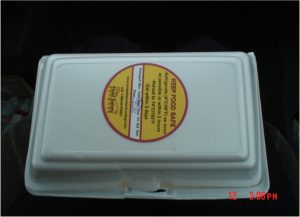Brantford, Ontario, my hometown where the telephone, Wayne Gretzgy and Massey-Ferguson combines were all birthed (it’s in Canada) has convicted a DIY caterer linked to a food poisoning outbreak last year.
 Lana Plank of Lana Plank Catering was fined $500.
Lana Plank of Lana Plank Catering was fined $500.
Plank was charged last December after an extensive investigation into how about 100 people became sick after eating a lunch she prepared in September 2015.
Those affected were among more than 150 people at a daylong workshop held by Brant Family and Children’s Services at the South Dumfries Community Centre in St. George. The resulting illnesses – cramps, diarrhea, headaches and nausea – affected the agency for days with some staff feeling the effects two weeks later.
The investigation tracked the problem to the egg and potato salad wraps made and served by Plank. The food was contaminated with plesiomonas shigelloides, inked to raw shellfish and unsanitary conditions, and enterotoxigenic escherichia coli, a common cause of traveller’s diarrhea.
Plank was not a registered caterer in Brant County at the time of the incident, nor inspected by the Brant County Health Unit. But justice of the peace Audrey Greene Summers was told Plank, a resident of Waterford, is a registered caterer in Norfolk County.
She was originally charged with operating a food premise without notifying the health unit but that charge was dropped upon her guilty plea.
Defence lawyer John Renwick said Plank has been in business for many years and has worked for a long-term care facility with no previous problems.
Renwick said Plank believes the symptoms suffered by the agency employees could have been part of a wider bug going around the community.
“Those are suspicions on her part but she’s not in a position to challenge (the agreed upon facts),” said Renwick.
He also noted that Plank did not receive a list of food to which people were allergic.
The case drew the attention of Public Health Ontario and saw the local health unit interview many of those affected, solicit surveys from others and obtain results from several laboratories. The case was based on stool samples and an extensive analysis of data.
“I’d like to commend our staff for their hard work on this incident,” Jeff Kowal, manager of environmental health for the health unit, said in written statement released late Tuesday.
“This was a prime example of the important role the health unit plays in investigating cases of food-borne illness to keep our community safe and healthy.”
Kowal said food safety is taken seriously by the health unit. All food service workers must use safe food handling practices to prevent food-borne illnesses.
He reminded people hiring a caterer to first visithttp://inspectionreports.bchu.org to see the reports on inspected caterers.
Maybe the Brant County health unit should practice what it preaches.










